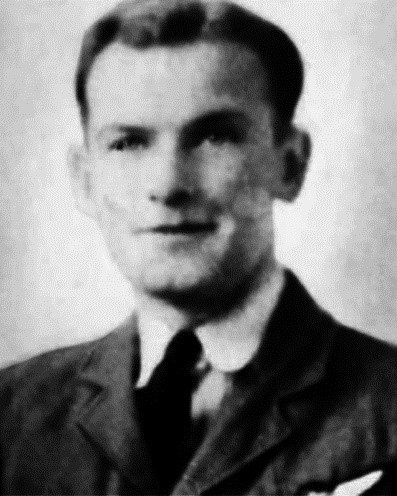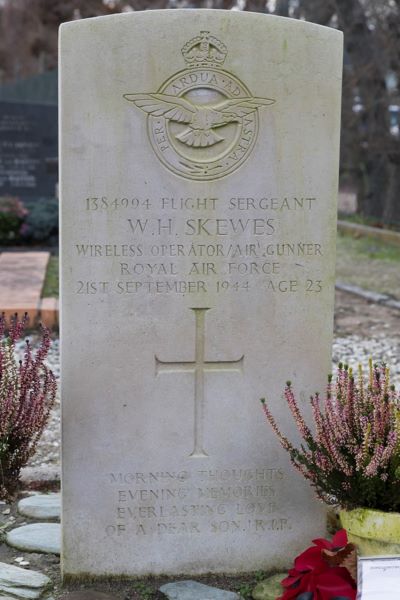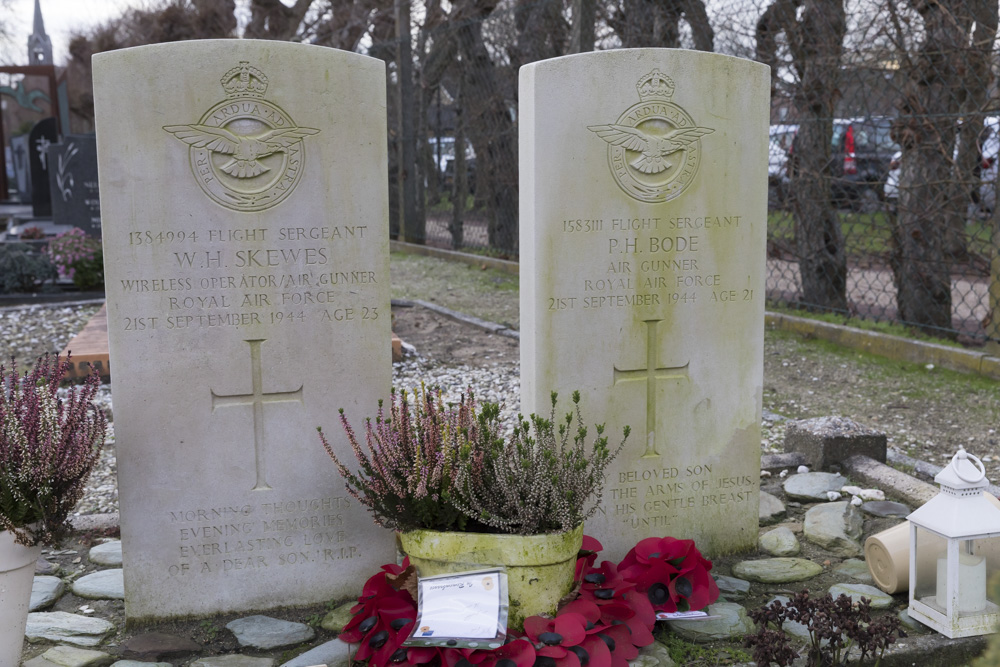Skewes, William Henry
- Date of birth:
- May 31st, 1921 (Camborne/Cornwall, the United Kingdom)
- Date of death:
- September 21st, 1944 (in the vicinity of Horssen-Bergharen/Gelderland province, the Netherlands)
- Buried on:
- Commonwealth War Graves Catholic Cemetery Roman Catholic Cemetery Wijchen
Grave: 1. - Service number:
- 1384994
- Nationality:
- British
Biography
William Henry Skewes was born at 31 May 1921 in Camborne, Cornwall, the United Kingdom. He was the son of William Henry and Gladys Mary Skewes and had two sisters. Little is known about his youth. Before entering the Royal Air Force Volunteer Reserve he reportedly was a rider/horseman who helped out his father.
Regarding his military career until September 1944 little information is known. For instance it is unknown when he joined the Royal Air Force Volunteer Reserve, nor is it known when he was assigned to No.190 Squadron or when he was promoted to Flight Sergeant. Regarding the squadron is known that it was initially formed as a Flying Boat Squadron of the Coastal Command, but on 1st January 1944 was disbanded. As of 5th January it was transformed into an Airborne Forces Squadron and in March it took part in a number of largescale glider exercises. The squadron flew with Stirling IV bomberplanes. As of late March 1944, the unit was stationed at Fairford, Gloucestershire County, and commenced droppings of Special Operations Executive (SOE) agents. Until operation Market Garden the squadron also conducted para-droppings and glider-towing operations.
From 17th until 23rd September 1944 the unit conducted 98 sorties to support operation Market Garden. The squadron suffered heavy losses where twelve aircraft didn’t return to Fairford. Of the ten Stirlings that launched from Fairford on the 21st September 1944, only three returned. Amongst the seven downed aircraft was Stirling IV, with number LJ 823, the plane in which Fight Sergeant William Henry Skewes that day was the wireless operator and air gunner; he had two jobs that day. The Stirling was conducting a supply mission to Arnhem and was hit in the tail near the gun turret by anti-aircraft artillery fire, while flying above the assigned drop zone. Then it was attacked by three German fighter aircraft.
The order to bail-out was given, but reportedly the aircraft was already flying too low. The navigator, Flight Sergeant Ross, jumped and landed safely, like the two air dispatchers, Poole and Woodley. They, managed to evade the Germans and eventually returned to Allied territory. Flight Sergeant Cairns (air bomber) jumped too, however, his parachute didn’t open in time and he died falling down. Warrant Officer Leslie John Billen (additional air bomber) was the second crewmember who didn’t survive the crash. According to an eyewitness account he was killed – while descending with his parachute – by a strafe of the returned German fighter planes. He fell down near the Aspert, a hamlet in Horssen, Druten municipality, near a canal called the Wetering.
At around 16:00 local time, the pilot, Flying Officer Farren, managed to conduct an emergency landing near the Diedense Uiterdijk in Megen, Oss municipality, but he was launched through the windshield on impact, sustained severe back injury and was hospitalized. Later he was taken prisoner of war by the Germans. Also air gunner, Flight Sergeant Brown, and aircraft mechanic, Flight Sergeant Stone, were injured and taken captive as prisoners of war. After the emergency landing the aircraft burnt out and was destroyed.
Skewes bailed out right behind Flight Sergeant Cairns and allegedly also his chute didn’t open in time. Another reading would be that he encountered the same fate as Leslie John Billen and was shot and killed by the returning enemy planes while descending with his parachute. Anyhow, William Henry Skewes died as the third crewmember of the LJ823, while six survived. William was 23 years of age. He is buried at the Roman Catholic graveyard of the Sint-Antonius church in Wijchen, war grave no.1. In Leedstown, Cornwall, he is commemorated with a memorial named ‘the Men of Crowan’.
Do you have more information about this person? Inform us!
Sources
- Photo 1: veteranen Wijchen
- Photo 2: Arjan Vrieze
- - Flight Sergeant William Henry Skewes | War Casualty Details 2648364 | CWGC
- Sgt William Henry Skewes (1921-1944) - Find a Grave-gedenkplek
- Stirling IV LJ823 [Royal Air Force Aircraft Serial and Image Database] RAFCommands.com
- Air Forces WW2 Casualty : (), [RAFCommands]
- Accident Short Stirling Mk IV LJ823, Thursday 21 September 1944
- Bijzondere bijeenkomst voor geallieerde helden - Wijchens Weekblad Wegwijs
- William Henry Skewes - Stichting Veteranen gemeente Wijchen
- Royal Air Force - Stichting Veteranen gemeente Wijchen
- https://memorials.aroundbritain.org.uk/index.php?country=England
- Brief van Mrs van der Neut-Loeffen, Wychen 27 december 1990. | Vrijheidsmuseum | Collectie Gelderland





